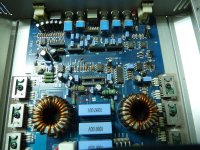took a good luck under the PCB, all looks fine. put it all back together, powers up fine, got nothing on the output, at all. still not playing any signal.
dunno what to check next..
David
dunno what to check next..
David
relay engages. im a bit scared to push on the board again, dont want to burn anything out.
but i did notice voltage rail drop from almost 40vac per rail to 22vac per rail when i had the HIP4080 in and out. when out the rail voltage was higher, when in lower. that also seems strange. yet there is no difference in current draw.
David
but i did notice voltage rail drop from almost 40vac per rail to 22vac per rail when i had the HIP4080 in and out. when out the rail voltage was higher, when in lower. that also seems strange. yet there is no difference in current draw.
David
Where did you measure the rail voltage?
You need to measure it on the center leg of the rectifier.
You need to measure it on the center leg of the rectifier.
Where did you measure the rail voltage?
You need to measure it on the center leg of the rectifier.
Do i measure between the center leg of the rectifier and the center tap?
EDIT: messured center leg to center tap with 4080 in place and got 70vdc more or less..
Last edited:
I don't know why that would have changed so much. It could have been an error caused by the changing pulse width (assuming that the rail voltage is regulated).
Do you have 35v DC on the positive and negative speaker temrinals? Place the black meter probe on the secondary center tap. Place the red meter probe on the point where you need to measure the voltage.
Do you have 35v DC on the positive and negative speaker temrinals? Place the black meter probe on the secondary center tap. Place the red meter probe on the point where you need to measure the voltage.
measured from ceter top to negative output terminal. 0v. from center tap to positive output terminal get 3vDC and 7vAC.. from center tap to middle pin on the rectifiers get 72ish volts DC.
What's the resistance from the negative speaker terminal to the secondary CT?
Do this with no power applied.
Do this with no power applied.
ill have to test that in a weeks time, off to the army till next Monday. thank you for the time and patients with me. ill post up measurements next week once i arrive back home.
Thanks,
David
Thanks,
David
when i measure between the outputs and center tap i get a resistance reading that just rises and rises until im out of range on the DMM..
David
David
made a nice discovery right now. remember i told you that i was reading 7VAC/3.7VDC on the positive output terminal, zero on the negative?
now i took out the 4080 and tested both terminals.
positive stayed the same, but the negative terminal has 9VAC/5VDC without the 4080 in place. what can i learn from that? maybe the FET's are bad?
now i took out the 4080 and tested both terminals.
positive stayed the same, but the negative terminal has 9VAC/5VDC without the 4080 in place. what can i learn from that? maybe the FET's are bad?
I think the outputs are probably Ok. Generally, when the outputs are shorted, the speaker terminals are either shorted to the secondary CT or they have full rail voltage on them. When they're floating at voltages in-between the secondary CT and the rail, they are almost always OK unless they have intermittent connections on the legs of the transistors (most commonly broken at the body of the transistor).
gosh these class d amps are complicated haha..
i got 3 lm393's in the amp, is there any way to check them? and the op amps in the pre amp section? im just gonna test every thing to make sure i got no bad parts in there..
AND ive found a shorted diode! 🙂
i got 3 lm393's in the amp, is there any way to check them? and the op amps in the pre amp section? im just gonna test every thing to make sure i got no bad parts in there..
AND ive found a shorted diode! 🙂
Last edited:
There's a way to check them but it would require that you post the voltage on every pin of every IC you want to check which would be time consuming and probably unnecessary (but it's up to you).
What diode was shorted?
What diode was shorted?
That's a transient surge suppressor (acts much like a Zener diode). They rarely short unless the outputs fail. Re-check the diode after the amp has had no power applied for a few minutes.
Double-check the outputs to confirm that none have failed.
Double-check the outputs to confirm that none have failed.
- Status
- Not open for further replies.
- Home
- General Interest
- Car Audio
- Hifonics BX1605D repaire
